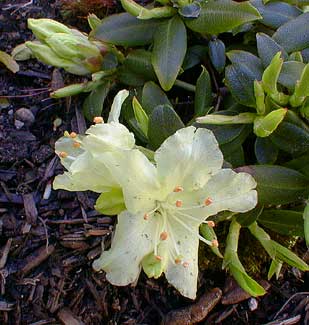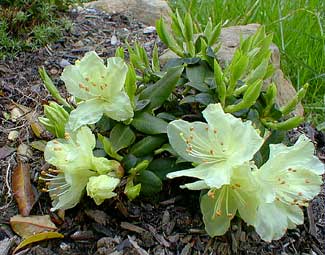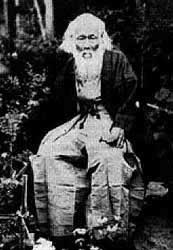
'Yaku Fairy' Dwarf Rhododendron
"The flowers are sighing forth their sweets
To wooing honey-bees."
-Sarah Josepha Hale
(1788-1879)
(1788-1879)
'Yaku Fairy' is a strain of Rhododendron keiskei var. cordifolia with a ten-year height of six inches or at maximum a foot.
The species is overall quite variable in growth, as some strains would never exceed a scant inch or two in thirty years, taking the idea of dwarf rhodies to extreme. Forms exist that can reach ten feet, but the majority would not exceed two feet in a decade.
The variant cordifilia is one of the most intensely prostrate forms. Its growth is exceedingly dense so that its structure is hidden by leaves.
This lepidote or scaly rhododendron can over a great length of time spread to two feet, even while remaining under six inches high. It is much the smallest of the dwarf species rhodies Granny Artemis & I possess.
 Our specimen is nearly flat to the ground, & only time will tell if it will spread while remaining ultra-short, or if it gains a few inches of height in years to come.
Our specimen is nearly flat to the ground, & only time will tell if it will spread while remaining ultra-short, or if it gains a few inches of height in years to come.The blooms remain tight & close to the dense olive-green foliage. Ours is a moderately fine bloomer at only two or three inches height & six or seven inch spread, & the blooms are comparatively big considering the tininess of the shrub.
The pallid off-white to creamy yellow trumpets, with salmon anther tips, are about an inch & a half wide each. They are well-colored even when still buds in early April. There can be as few as two, or as many as six of the flattened bells per truss. (See more of this shrub on the 'Yaku Fairy' page of the Rhodies & Azaleas Blossoms Gallery.)
'Yaku Fairy' & other ultra-dwarf forms of the species have been used in elaborate hybrid programs to produce numerous dwarf cultivars, extending the color range of the usually-purple lepidotes, & creating micro shrubs out of species that tend to be two-foot dwarves. Ours, however, is a species form, not a hybrid, obtained through the Rhododendron Species Federation.
 Most alpine dwarf rhodies like nearly full sun, but 'Yaku Fairy' requires a bit of shade, so is planted underneath the Paperbark Maple near the foot of the dwarf Spider Azalea which even though itself quite small is huge compared to the Yaku Fairy. Another micro-shrub grows nearby, a super-miniature form of dwarf lingonberry, which is a mere inch or two tall, with very slowly spreading carpetting habit.
Most alpine dwarf rhodies like nearly full sun, but 'Yaku Fairy' requires a bit of shade, so is planted underneath the Paperbark Maple near the foot of the dwarf Spider Azalea which even though itself quite small is huge compared to the Yaku Fairy. Another micro-shrub grows nearby, a super-miniature form of dwarf lingonberry, which is a mere inch or two tall, with very slowly spreading carpetting habit.R. keiskei is named for Meiji Era botanist Keisuke Ito (1803-1901), whose portrait is the photo on the left. The species has been grown in the west since 1908, though the naturally prostrate 'Yaku Fairy' was introduced much later.
The species as a whole is not the most cold-hardy of alpine dwarves. They don't usually like temperatures below ten degrees F. & would not do well below zone 7. This prostrate form, however, is hardier, & its buds are not at much risk of winter-damage until temperatures fall to minus 15.
In the wild it grows in rocky areas of central & southern Japan. In the southernmost Yakushima Mountains it is occasionally encountered growing in trees as if it were an epiphyte.